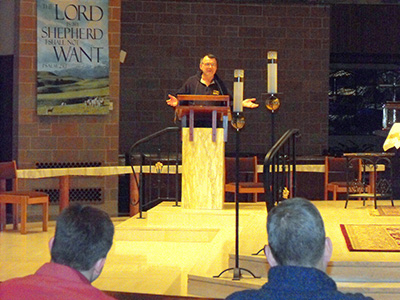
By Michael Rizzo
Thursday nights this time of year are usually quiet inside American Martyrs Church, Bayside. But this winter, the altar of the church is lit on Thursday evenings for a special purpose: to train the next class of diocesan permanent deacons in the art of giving a proper homily.
The deacons-in-training are part of a 10-week program studying homiletics provided by the Diaconate Office.
The sessions at American Martyrs are led by Deacon Stanley Galazin, who serves the parish. There are five candidates for the diaconate studying under Deacon Galazin and another 14 are training at Our Lady of the Snows, North Floral Park. All are scheduled to be ordained May 23.
“When the deacons are ordained, they are presented with the Book of the Gospel and they are reminded to read, believe and teach the Gospel,” Deacon Galazin said.
“It’s been stressed to us to not take homilies lightly,” Nick Scarlatto of St. Francis of Assisi parish, Astoria, said. “It requires prayer and reflection. That’s integral to a good homily.”
The night actually begins with evening prayer from the Liturgy of the Hours. Then the men practice what they will preach. Each one reads from a previously assigned Gospel selection and delivers a homily.
After each talk, Deacon Galazin offers his critiques on things like the homily’s introduction and finish and whether it had a clear message or too many points. He offers advice on making eye contact and about not reading from a script but urges the men to use outlines.
Deacon Galazin says the mechanics of speaking do count but reinforces that what comes from inside the homilist is more important.
“Mechanics can be taught in speech class,” he says, “but you need to be a person of prayer. Without prayer you are empty.”
Eugene Cassidy of Sacred Heart, East Glendale, says he’s not nervous about speaking to a congregation but has other concerns.
“I want to be sure I’m getting the teachings of the Church correct,” he said.
He also said he’s sat through long evangelical sermons and that it can be a challenge to present a shorter homily.
Phil Franco, of Our Lady of Mount Carmel, Williamsburg, and the principal of St. Margaret’s School, Middle Village, says his biggest concern is being relevant.
“I want to say something that parishioners can take with them. You have to know who your audience is. And in your home parish, people usually know you, so you need to be authentic.”
With each homily, the group offers their own thoughts and the comments are generally positive.
“There’s a support system to help us get through the training together,” Paul Norman of Our Lady of Hope said. “After I read the Gospel to prepare my homily, I pray on it, write a draft, ask my colleagues to help correct it and then tweak it again.”
Each homilist seems to have his own way to connect the Gospel and the homily. For some, it’s an apocryphal story they’ve heard or maybe a real-life remembrance about a family member. Others just link the Gospel to another reading from the Mass. For Stan Tam of St. John Vianney, Flushing, who will preach primarily in Chinese after he’s ordained, he speaks from his life experiences.
“I look at the readings, find a theme and then look for a story in my own life to apply it,” he explains.
About two hours after the training began and with five inspirational homilies still seeming to echo through the church’s nave, these soon-to-be-deacons head back out into the cold night air with a new mission: homiletics homework to keep reading, praying and practice preaching.
